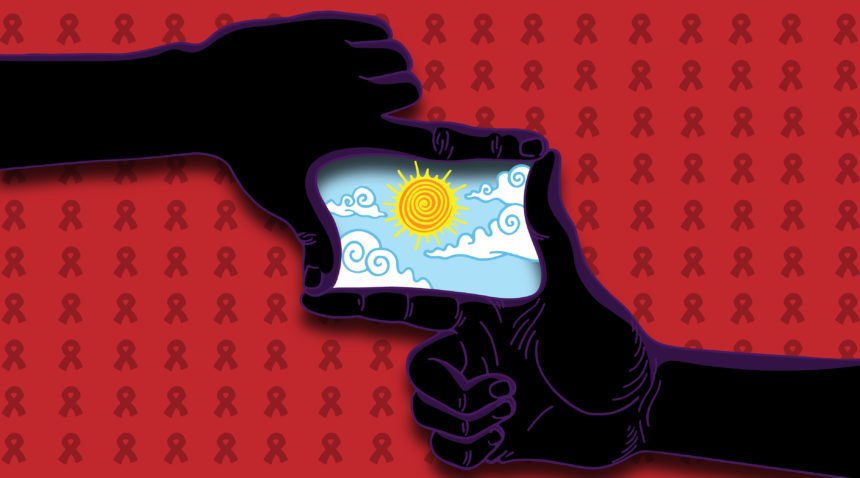When you think of someone who could develop post-traumatic stress disorder, you might think of a soldier returning home from war or a survivor of childhood abuse. But what about someone with cancer? Turns out being diagnosed can also cause the hallmark anxiety and fear of PTSD.
A study published by the American Cancer Society showed that roughly 1 in 5—nearly 22 percent—of people who received a cancer diagnosis developed symptoms of PTSD within six months.
Post-traumatic stress disorder is a condition caused by mental and emotional stress that typically occurs as a result of an injury or traumatic event.
“PTSD can occur in any person who is exposed to death or the threat of death,” says Theresa Raphael-Grimm, PhD, a psychotherapist and professor of nursing and medicine at UNC. “With cancer, the stressor, or event that sets people off, is the diagnosis. Just as in war, patients find themselves in a situation that has the potential to end their life.”
The study also found that more than 6 percent of patients still experience PTSD-related symptoms four years later.
“It’s an interesting phenomenon because once patients are done with treatment, their clinicians, family and friends might think, ‘OK, they’re done. They can get back to their life, pick up where they left off, before cancer.’ But many patients report that that’s not the case. Rather, they never really return to life the way it was pre-cancer,” Dr. Raphael-Grimm says.
“They’ve been changed by the experience. It leaves them with a sense of vulnerability that can be difficult to cope with.”
What PTSD Looks Like with Cancer
Symptoms of PTSD usually last longer than three months and have the potential to disrupt daily life. Because stress can manifest in different ways, symptoms of PTSD can be complicated and hard to pinpoint. Some might experience nightmares or flashbacks in which they relive the horror and fear of an event, while others might avoid situations that remind them of the trauma.
“Patients might find themselves driving the long way around town so they don’t have to pass by the hospital, because even seeing the hospital can trigger anxiety or a sense of doom,” Dr. Raphael-Grimm says.
Hyperarousal, or feeling alert or jittery at all times, as well as negative changes in personality and beliefs, can also indicate PTSD.
But even when symptoms are evident, some cancer survivors never get a PTSD diagnosis. That’s because clinics have a certain set of criteria to diagnose people, and what they often find with cancer patients is that they don’t fit all of the diagnostic criteria for PTSD, but they have many of the symptoms, Dr. Raphael-Grimm says.
“Either way, their anxiety needs to be treated.”
Why Is PTSD More Common in Cancer Than Other Diseases?
Dr. Raphael-Grimm says PTSD might be more common in people who have experienced cancer, as opposed to other illnesses, because active treatment can require frequent visits, last for a long period of time and end without the certainty of a cure.
“It’s not the same as being in a car accident and having the event be over, and then going through some kind of surgery and rehabilitation,” she says. “With cancer, the treatment can be ongoing. And at each step of the way, things can go well, and there can also be setbacks.”
Though many types of cancer can be treated and cured, a lot of people associate cancer with a risk of death. Hearing that you have it forces you to face your own mortality, which in itself can be traumatizing.
A cancer diagnosis is often someone’s “first exposure to this sense of fear: ‘Oh no, I have a potentially life-threatening illness,’” Dr. Raphael-Grimm says.
Each phase of treatment—as well as any setback—carries a lot of questions that can trigger insecurity. “For example, what does each one of the treatment options mean for the patient? How will the treatment impact a patient’s quality of life and ability to meet work and family responsibilities?” Dr. Raphael-Grimm says. “Constantly nagging in the back of patients’ minds is the question: ‘Is the treatment going to work?’”
Cancer Resources
Despite the anxiety and fear a cancer diagnosis might bring, there are a variety of resources available to you or your loved ones to help them lead a healthy life. Dr. Raphael-Grimm suggests patients ask one important question: How can you be your own best advocate for better health?
For some, this might mean engaging in proactive behaviors such as developing a healthy diet, exercising, getting outside, spending time with loved ones or working to lower stress levels.
For others, this might mean participating in cancer support groups and classes. The UNC Lineberger Comprehensive Cancer Center’s support program offers a variety of resources, including counseling and mental health services, exercise programs, nutritional support, group therapy and more.
Dr. Raphael-Grimm says these types of resources can help people “disengage from the worry,” help promote a healthy lifestyle and ultimately reduce the risk or symptoms of PTSD.
Learn more about the resources available at UNC Lineberger Comprehensive Cancer Center.

